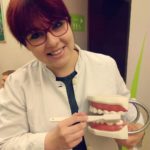
Early childhood caries
A very interesting topic, and at the same time a topic that is so often skipped and marked as UNNECESSARY!? Questions such as, “Should baby teeth be brushed? Do baby teeth need to be treated and repaired? ”Or sentences of the type:“ My baby’s teeth have broken and blackened by themselves. ”-> are just some of the must-have questions I face on a daily basis. Today in this article I bring you all about early childhood caries. I believe it’s worth taking a minute to read.
Early childhood caries
Early childhood caries is a disease that is considered a more severe form of dental caries due to the characteristic rapid progression of the lesion process, specific localization, the risk of dental pulp infection (commonly known as dental nerve), and the possibility of a final consequence – tooth loss. Early childhood caries usually occurs in children whose teeth are less mineralized, and the food they consume is mushy and soft in consistency and does not require much chewing. The soft deposits of food on the dental surfaces lead to the accumulation of dental plaque, which, if not mechanically removed, causes the activation of the carious lesion.
The mouth of a newborn baby is sterile in most cases. The microorganisms that inhabit the oral cavity are transmitted by water, food and other nutrients, but saliva is the most important. Numerous studies have shown that the most common type of transmission of oral streptococci and gram-bacteria is precisely vertical transmission, from mother to child.
Early childhood caries can be classified into two age groups:
Age group from 1 to 36 months of age
Early childhood caries in the age group from 1 to 36 months of age most commonly occur on the frontal incisors and the first milk molars. The names that also apply to this type of caries are rampant caries and bottle caries because caries is associated with bottle feeding or long-term breastfeeding. Failure to identify and treat early childhood caries can lead to rapid progression and pulp involvement.
This type of caries manifests as a lesion that engages the gingival third of the upper incisors, while the lower incisors most often remain intact.
If the baby caries is not restored early, if the caries process is active, then the infection of the other teeth will spread further and the caries will affect canines, first and second molars. If the episodes of early caries last for a short time and can be stopped before further progression, there remain “scars” on the teeth, which are later predilection sites for the formation of caries lesions. From the third year of a child’s life, caries can develop in fissures and pits of milk molars and in approximate surfaces, if the contact points are closed.
Age group from 3 to 6 years of age
Early childhood caries in the age group of 3 to 6 years of age most commonly occur in fissures and pits of milk molars and in the approximate (lateral) surfaces of all milk teeth. Early diagnosis of early infant caries of approximate surfaces is very important and early detection is based mainly on radiological recordings and close clinical examination. If the caries is not detected and repaired in a timely manner, there will be extensive destruction of hard dental tissues and the formation of approximate cavities with complete loss of contact points, which subsequently leads to the loss of sites for permanent heirs and orthodontic anomalies.
Treatment and prevention
Age group from 1 to 36 months of age – in the treatment of early childhood caries in the period from 1 to 36 months of a child’s life the biggest problem is the child’s uncooperativeness, which is a consequence of fear of unknown persons, stress and mental immaturity and impossibility understanding the importance and plan of the therapeutic procedure. The main goal and task in this age group is to stop the caries process and destruction of dental tissue. Restoration of lost and damaged dental tissue should be delayed until the child is ready to accept restorative treatment and therapy. Local and general prevention procedures should be used to further prevent and preserve the passivity of caries lesions.
Local prevention procedures include professional cleaning, application of fluoride preparations, and thin sealing of glass ionomer materials. General prevention procedures include regular annual controls and an informative interview with parents, which provides information on the child’s unwanted habits, such as high sugar consumption, night meals, inadequate oral hygiene, and the like. Caution should be exercised when discussing with parents so as not to refuse to cooperate and close communication between the therapist and the parent, as many parents will feel failure. Bad habits, such as night meals, cause stress for parents and children when abolishing them, so parents should be motivated to cooperate.
Also, in the case of young children, the problem of poor cooperation is already mentioned, and the inexperienced parent may find it difficult to perform adequate oral hygiene of the child. Parents should be referred to specialized and tailored oral hygiene equipment tailored to the target age range of 1 to 36 months, such as a toothbrush to put on your finger, specialized sterile oral wipes, and the like.
Age group from 3 to 6 years of age – in the treatment of early childhood caries in the age of 3 to 6 years it is possible to make restorative therapeutic procedures, since the children are more cooperative, mentally mature and show interest and understanding to solve the problem of pain and discomfort. For therapeutic procedures, resins, composites, compomers and glass ionomer cements are used as restorative materials.
There are a variety of psychological techniques that are used to facilitate a child’s and successful collaboration with the therapist, and one of the most commonly used techniques is tell-show-do.
Emphasize the use of topical fluoridation therapy and professional teeth cleaning and fissure sealing.

Author: Iva Tomić, Univ. Bacc. Dent. Hig
Dental hygienist view

I give consent to Be Seen Be Popular (BSBP) to process and use my personal information ( name and e-mail address ) in order to answer to my inquiry and send information associated with this website.